WORLD CLASS COACHING
40 Small-Sided Games
By Luca Bertolini
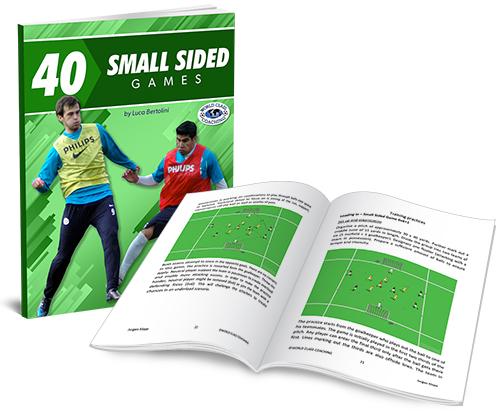
Table of Contents
PART FOUR
8v8 and 9v9 Small-Sided Games
8 v 8 Exercises (1)
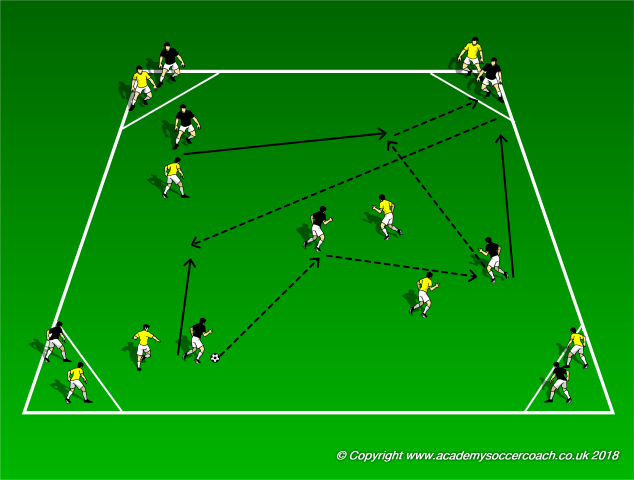
Set-up and Sequence: an 8 v 8 duel is played inside a rectangular space that is organized as in the picture. A 4 v 4 is played in the middle and 1 v 1 duels inside corner spaces.
The goals for the possession team are to allow all the 4 players in the middle touching the ball (1 point), then to try to play a 3rd man passing combination with one of the players inside the corner spaces.
As this fifth player passes the ball back inside, he must exchange the positions with one of the middle teammates (1 more point). The 1 v 1 duels inside the corner spaces are fully active.
If the defenders win the ball, they must play the same way.
Eye on: quick passes combinations; find the 3rd man with one touch pass.
8 v 8 Exercises (2)
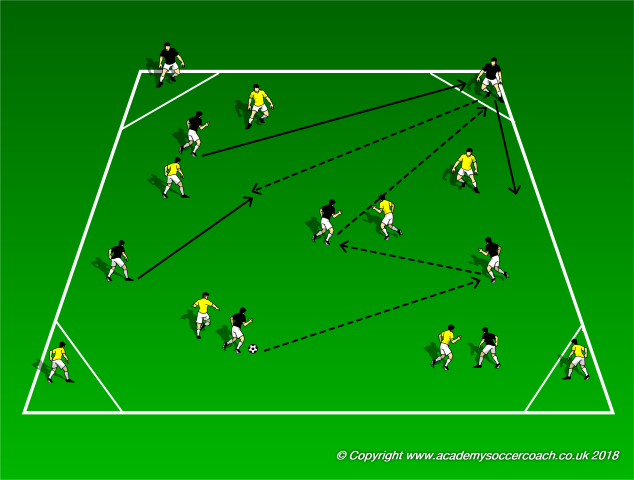
Set-up and Sequence: this practice is a variation of the previous one. A 6 v 6 is played in the middle and 2 players for each team are inside the corner spaces, as in the picture.
The goals for the possession team are to allow 5 players in the middle touching the ball (1 point), then to try to play a 3rd man passing combination with 1 of the 2 players inside the corner spaces.
As this fifth player passes the ball back inside, the sixth one, who didn't touch the ball, must exchange the positions with the teammate inside the corner before (1 more point).
Each team must play toward 2 corners as well as it has 2 corners to defend.
If the defenders win the ball, they must play the same way toward the opposite side.
Eye on: quick passes combinations, keep the possession outnumbered (5 v 6) as 1 player doesn't have to touch the ball, find the 3rd man with one touch pass.
8 v 8 Exercises (3)
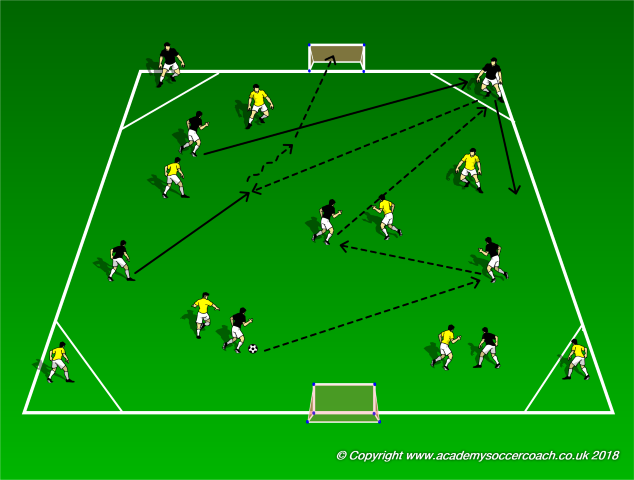
Set-up and Sequence: this practice is a progression of the previous one. A 6 v 6 duel is played in the middle and 2 players for each team are inside the corner spaces, as in the picture. Each team has now a goal to attack and a goal to defend.
The goals for the possession team are to allow 5 players in the middle touching the ball (1 point), then to try to play a 3rd man passing combination with 1 of the 2 players inside the corner spaces and to finish scoring in the mini-goal.
As this fifth player passes the ball back inside, the sixth one who didn't touch the ball, must exchange the positions with the teammate inside the corner before (1 more point). The finishing phase is free for all the other players.
If the defenders win the ball, they must play the same way toward the opposite side.
Eye on: quick passes combinations, keep the possession and finish outnumbered (5 v 6) as one players doesn't have to touch the ball, find the 3rd man with one touch pass.
8 v 8 Exercises (4)
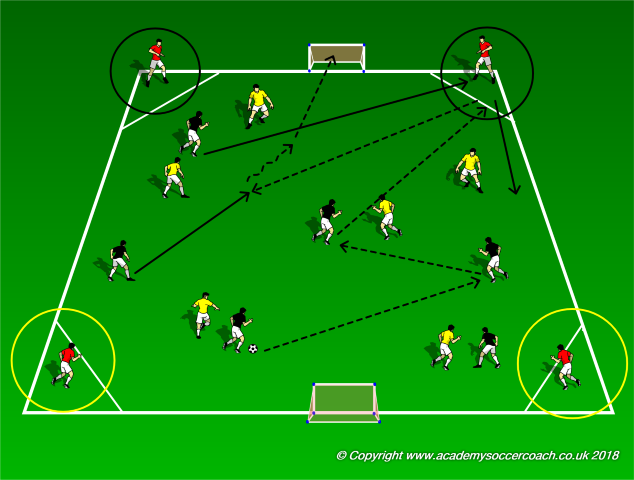
Set-up and Sequence: a 6 v 6 duel is played in the middle and 4 neutral players are placed inside the corner spaces, as in the picture. Each team has again a goal to attack and a goal to defend. The goals for the attacking team are to allow 5 players in the middle touching the ball (1 point), using all the 4 neutral players to keep the possession, to try to play a 3rd man passing combination with 1 of the 2 players inside the corner spaces and to finish scoring in the mini-goal to be attacked (in this situation the nearest neutral players to goal must support the forwards; the other 2 become defenders).
As the fifth player passes the ball back inside, the sixth one who didn't touch the ball, must exchange the positions with 1 of the attacking neutral players inside the corner before (1 more point); they exchange the role too. The finishing phase is free for all the other players.
If the defenders win the ball, they can counter-attack 6+2 neutral fix players v 6 toward the opposite side.
Eye on: quick passes combinations, keep the possession exploiting the numerical advantage during possession phase, finish after a wall passing combination and find the 3rd man with one touch pass.
8 v 8 Exercises (5)
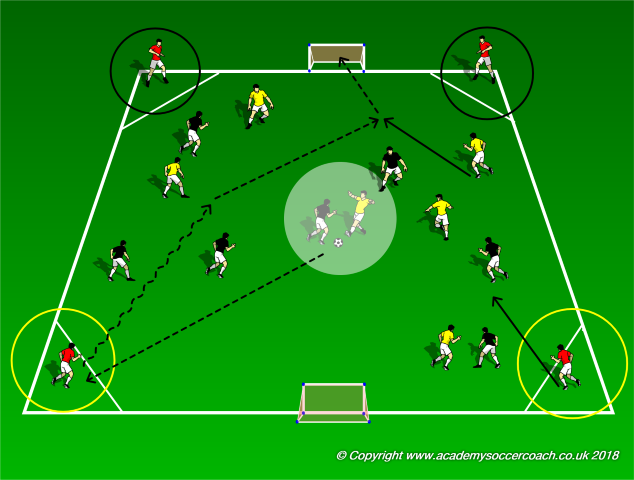
Set-up and Sequence: this is a progression of the previous exercise to coach the transitions to attack.
If the defenders win the ball, playing the same previous game, they can counter-attack only after a back pass to 1 of the supporting neutral players, who dribbles inside as he receives to attack 8 v 6; the second one runs inside too.
Eye on: quick passes combinations, pressure to win the ball, build up fast pattern of play to counter.
9 v 9 Exercises inside half pitch (1)
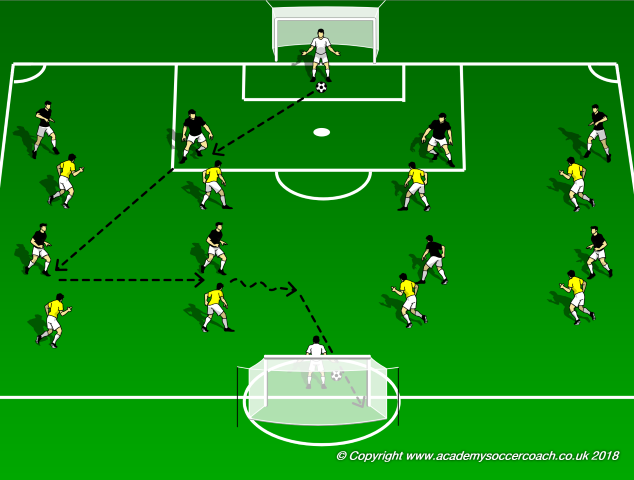
Set-up and Sequence: a 9 v 9 (goalkeepers are included) is played inside a half of a field. The players are positioned on 2 alternated lines of 4 and both the goalkeepers have a ball to pass. The coach decides which goalkeeper plays the ball, as well as the goalkeeper can decide the team in possession.
The direction of play is now identified.
The attacking team must score overcoming 1 or 2 lines of pressure depending on which is the first group of players in possession; the nearest to the goalkeeper or the further one. If the defenders win the ball a free 8 v 8 field duel is played.
As the first sequence ends, the second goalkeeper plays the second ball in the same way.
Variation: if the defenders win the ball, they must build up from the back, before being able to attack and finish.
Eye on: break through the opposition lines, play vertical passes as soon as possible, finish quickly.
9 v 9 Exercises inside half pitch (2)
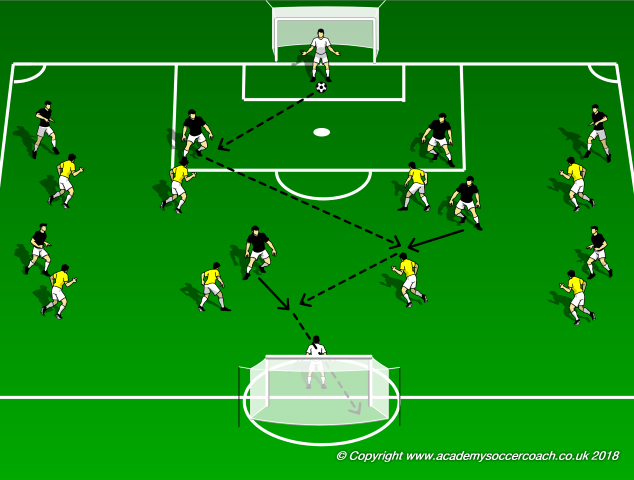
Set-up and Sequence: this practice is a variation of the previous one.
The goalkeeper of the attacking team has the possession and the goals are to break through the defending pressure lines of 4, before finishing.
The defending team must always try to win the possession to counter-attack.
The role of the teams is inverted after a fixed limit of time.
Variation: if the defenders win the ball, they must build up from the back before being able to attack and to finish.
Eye on: break through the opposition lines, counter-attack as quickly as possible.
9 v 9 Exercises inside half pitch (3)
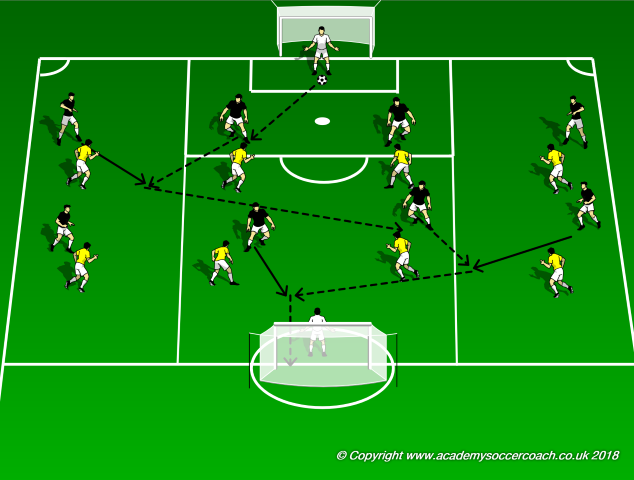
Set-up and Sequence: a 9 v 9 (goalkeepers are included) is played inside a half of a field. The half pitch is divided into 3 areas. 2 v 2 duels are played along the flanks and a 4 v 4 is played in the middle.
The goalkeeper of the attacking team has the possession and the goal is to break through the defending pressure lines before finishing. The build up phase must be directed toward one flank (on the right in the picture), the first pressure line must be overcome through the middle, changing the side toward the opposite flank (on the left) before finishing.
The defending team must always try to win the possession to counter-attack.
The role of the teams is inverted after a fixed limit of time.
Variation: if the defenders win the ball, they must build up from the back and finish, as the attacking team must do.
Eye on: win the duels with equal number of players, break through the opposition lines, change the side with the fewer number of touches possible, and counter-attack as quickly as possible.
9 v 9 Exercises inside half pitch (4)
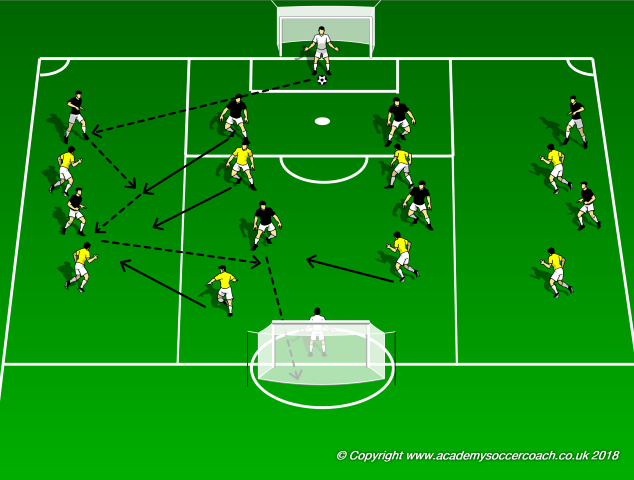
Set-up and Sequence: this practice is a variation of the previous exercise.
The goalkeeper of the attacking team has the possession and he must start the build up phase on one flank (on the right in the picture). The defending team must be able to overload the flank (4 v 3 in the picture) to win the ball back and to counter-attack.
The attacking team must be able to play out even if outnumbered and to finish inside the center area. If the direction of play must be switched, the build up phase must be started again from the goalkeeper.
The role of the teams is inverted after a fix limit of time.
Variation: if the defenders win the ball, they must build up from the back and the opposition must overload the flank to prevent the playing out phase of play.
Eye on: win the outnumbered duels to play out, break through the opposition pressure, and overload the ball area to win the ball back.
9 v 9 Exercises inside half pitch (5)
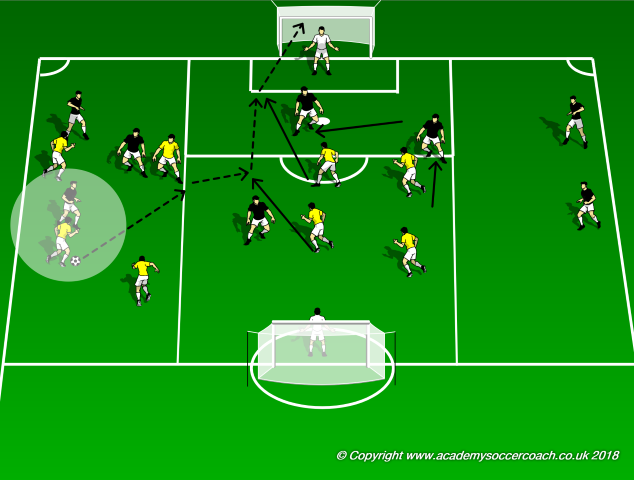
Set-up and Sequence: this practice is another variation of the previous exercise to coach the transitions to attack.
The game situation is the same of the previous exercise. If the defending team wins the possession, the center area must be overloaded (4 v 3) to counter-attack.
The outer players of the team now in possession must run inside to create numerical advantage to counter-attack.
Variation: the outer players of the team now in possession can overload the center area to create defending numerical advantage 5 v 4 to counter-press, to win the ball and to counter-attack.
Eye on: exploit the numerical advantage to finish quickly, save the goal space, when the team is outnumbered.


